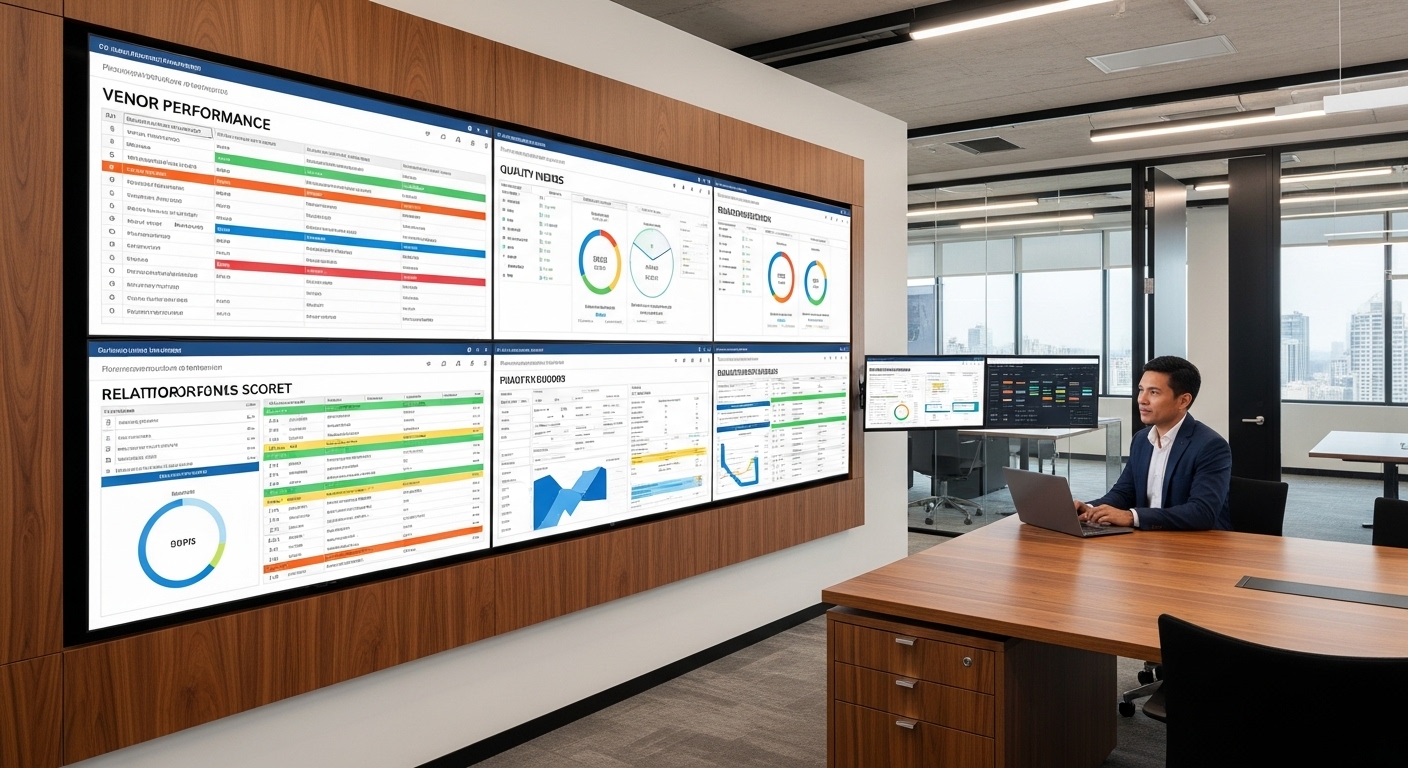July 29, 2025 by 100XBuilds Team
Luxury Builder Vendor Optimization: Strategic Supply Chain

When Toll Brothers reduced their vendor base by 23% while simultaneously increasing project completion rates by 18%, they proved that strategic vendor relationship optimization isn't just about cutting costs—it's about building a supply chain that drives competitive advantage in the luxury custom home market.
For builders managing $5M+ annual revenues, your vendor relationships represent more than procurement transactions. They're strategic partnerships that directly impact your project timelines, quality standards, and ultimately, your ability to deliver exceptional client experiences while maintaining healthy margins.
The Hidden Cost of Vendor Relationship Mismanagement
Most luxury builders focus on the obvious metrics: material costs, delivery schedules, and quality standards. But the real financial impact lies in the hidden inefficiencies that compound across every project.
Consider this: A typical luxury custom home involves coordination with 40-60 different vendors and subcontractors. When vendor relationships aren't optimized, builders experience:
- Project delays averaging 3-4 weeks due to coordination failures
- Change order costs increasing by 15-20% from poor communication
- Quality rework consuming 8-12% of project budgets
- Administrative overhead growing by 25-30% from managing too many relationships

One of our clients, a $12M annual revenue builder in Colorado, discovered they were managing relationships with 127 different vendors. After implementing a strategic vendor optimization program, they reduced this to 68 core partners while improving their gross margins by 4.2 percentage points.
The Strategic Framework for Vendor Relationship Optimization
Vendor Segmentation and Tiering
Not all vendor relationships deserve equal attention. Strategic procurement managers categorize vendors into three distinct tiers:
Tier 1 - Strategic Partners (15-20% of vendors, 60-70% of spend)
These are your mission-critical relationships that directly impact project success and client satisfaction. Think premium appliance suppliers, high-end millwork specialists, and your most skilled trade contractors.
Tier 2 - Preferred Suppliers (25-30% of vendors, 25-30% of spend)
Reliable vendors who consistently meet standards but don't require intensive relationship management. This includes standard electrical suppliers, basic plumbing contractors, and routine material providers.
Tier 3 - Transactional Vendors (50-55% of vendors, 5-10% of spend)
Commodity suppliers and occasional-use contractors managed primarily on price and availability.
Performance Metrics That Drive Results
Effective vendor relationship optimization requires measuring what matters. Beyond basic cost and delivery metrics, track these relationship-driven KPIs:
Quality Performance Index (QPI)
- Defect rates per project
- Rework requirements
- Client satisfaction scores related to vendor work
Collaboration Effectiveness Score
- Response time to communications
- Proactive problem identification
- Flexibility during change orders
Strategic Value Contribution
- Innovation suggestions implemented
- Cost reduction initiatives proposed
- Market intelligence shared

Building Strategic Vendor Partnerships
The Partnership Development Process
Transforming vendor relationships from transactional to strategic requires a systematic approach:
Phase 1: Relationship Assessment and Alignment
Conduct quarterly business reviews with Tier 1 vendors focusing on:
- Mutual business objectives and growth plans
- Capacity planning for upcoming projects
- Technology integration opportunities
- Quality improvement initiatives
Phase 2: Collaborative Planning Integration
Integrate key vendors into your project planning process:
- Share 12-18 month project pipelines
- Involve vendors in design review processes
- Create joint problem-solving protocols
- Establish shared quality standards
Phase 3: Performance Optimization
Implement continuous improvement processes:
- Monthly performance reviews with data-driven feedback
- Joint training programs for quality standards
- Shared investment in process improvements
- Collaborative cost reduction initiatives
Technology Integration for Vendor Management
Modern vendor relationship optimization leverages technology to streamline communication and improve coordination:
Vendor Portal Implementation
- Centralized communication platform
- Real-time project updates and scheduling
- Document sharing and approval workflows
- Performance dashboard access
Supply Chain Visibility Tools
- Material tracking and delivery coordination
- Inventory management integration
- Quality control documentation
- Payment processing automation
One luxury builder in Texas implemented a comprehensive vendor portal system and reduced project coordination time by 35% while improving on-time delivery rates from 73% to 91%.
Advanced Vendor Optimization Strategies
Strategic Sourcing and Market Intelligence
Top-performing builders leverage their vendor relationships for competitive intelligence and market advantage:
Market Trend Analysis Partner with key vendors to understand:
- Emerging material technologies and trends
- Pricing forecasts and market conditions
- Regulatory changes affecting construction
- Innovation opportunities in luxury features
Collaborative Product Development Work with specialized vendors to:
- Develop custom solutions for recurring design challenges
- Create standardized specifications that reduce costs
- Pilot new technologies and materials
- Build competitive differentiation through unique offerings

Risk Management and Contingency Planning
Sophisticated vendor relationship management includes comprehensive risk mitigation:
Vendor Financial Health Monitoring
- Quarterly financial stability assessments
- Credit monitoring and insurance verification
- Backup vendor identification and qualification
- Contract terms that protect against vendor failure
Supply Chain Resilience Planning
- Multiple sourcing strategies for critical materials
- Geographic diversification of vendor base
- Inventory buffer strategies for long-lead items
- Emergency procurement protocols
Performance-Based Contracting
Move beyond traditional fixed-price contracts to performance-based agreements that align vendor incentives with your business objectives:
Quality-Based Incentives
- Bonus structures for zero-defect delivery
- Penalty clauses for quality failures
- Shared savings from efficiency improvements
- Long-term partnership rewards for consistent performance
Innovation Incentives
- Revenue sharing for cost-saving innovations
- Preferred status for vendors who contribute ideas
- Joint investment in process improvements
- Recognition programs for exceptional partnership
Measuring ROI from Vendor Relationship Optimization
Financial Impact Metrics
Track these key financial indicators to measure the success of your vendor optimization efforts:
Direct Cost Savings
- Material cost reductions through strategic partnerships
- Administrative cost savings from streamlined processes
- Reduced change order costs from better communication
- Lower rework expenses from improved quality
Indirect Value Creation
- Faster project completion times
- Improved client satisfaction scores
- Enhanced reputation and referral rates
- Increased capacity for additional projects
Long-term Strategic Value
- Market intelligence and competitive advantages
- Innovation pipeline from vendor partnerships
- Risk mitigation and supply chain resilience
- Scalability for business growth

Implementation Timeline and Milestones
Months 1-3: Assessment and Strategy Development
- Complete vendor audit and segmentation
- Establish performance measurement systems
- Develop partnership criteria and selection processes
- Create vendor communication protocols
Months 4-6: Partnership Development
- Implement tiered relationship management
- Launch vendor portal and technology integration
- Establish performance review processes
- Begin strategic partnership negotiations
Months 7-12: Optimization and Scaling
- Refine processes based on initial results
- Expand successful partnership models
- Implement advanced performance incentives
- Measure and report ROI achievements
The Competitive Advantage of Optimized Vendor Relationships
Luxury custom home builders who master vendor relationship optimization create sustainable competitive advantages that extend far beyond cost savings. They build supply chains that enable:
Faster Market Response
- Quicker adaptation to design trends
- Rapid scaling for market opportunities
- Enhanced ability to meet tight client timelines
- Competitive advantage in bidding processes
Superior Quality Delivery
- Consistent execution of luxury standards
- Reduced quality variability across projects
- Enhanced client satisfaction and referrals
- Premium pricing justification through quality
Innovation Leadership
- Access to cutting-edge materials and technologies
- Collaborative development of unique solutions
- Market differentiation through exclusive partnerships
- Thought leadership in luxury construction
The builders who recognize vendor relationships as strategic assets rather than operational necessities will dominate the luxury custom home market in the coming decade.
Ready to transform your vendor relationships from cost centers into competitive advantages? Our supply chain optimization specialists have helped luxury builders increase project margins by an average of 3.8 percentage points while reducing completion times by 22%.
Schedule your vendor relationship optimization assessment today and discover how strategic partnership management can accelerate your growth while improving your bottom line.
